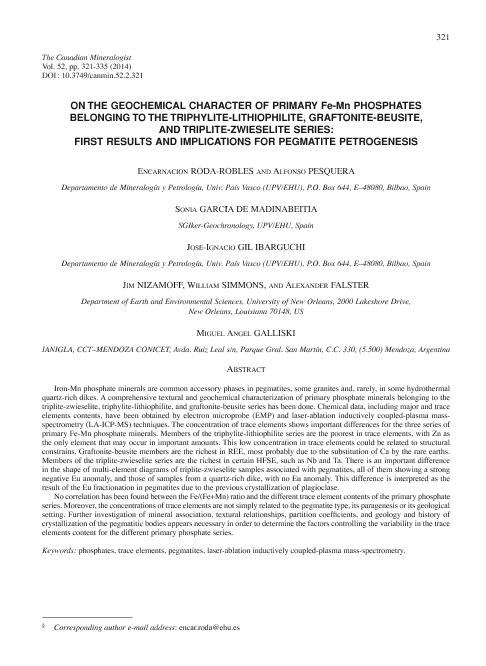Mostrar el registro sencillo del ítem
dc.contributor.author
Roda Robles, María Encarnacion

dc.contributor.author
Pesquera, Alfonso
dc.contributor.author
García de Madinabeitía, Sonia
dc.contributor.author
Gil Ibarguchi, José Ignacio
dc.contributor.author
Nizamoff, Jim
dc.contributor.author
Simmons, William
dc.contributor.author
Falster, Alexander
dc.contributor.author
Galliski, Miguel Angel

dc.date.available
2018-01-04T20:52:43Z
dc.date.issued
2014-06
dc.identifier.citation
Galliski, Miguel Angel; Falster, Alexander; Simmons, William; Nizamoff, Jim; Gil Ibarguchi, José Ignacio; García de Madinabeitía, Sonia; et al.; On the geochemical character of primary Fe-Mn phosphates belonging to the triphylite-lithiophilite, graftonite-beusite, and triplite-zwieselite series: first results and implications for pegmatite petrogenesis; Mineralogical Association of Canada; Canadian Mineralogist; 52; 2; 6-2014; 321-335
dc.identifier.issn
0008-4476
dc.identifier.uri
http://hdl.handle.net/11336/32370
dc.description.abstract
Iron-Mn phosphate minerals are common accessory phases in pegmatites, some granites and, rarely, in some hydrothermal quartz-rich dikes. A comprehensive textural and geochemical characterization of primary phosphate minerals belonging to the triplite-zwieselite, triphylite-lithiophilite, and graftonite-beusite series has been done. Chemical data, including major and trace elements contents, have been obtained by electron microprobe (EMP) and laser-ablation inductively coupled-plasma mass-spectrometry (LA-ICP-MS) techniques. The concentration of trace elements shows important differences for the three series of primary Fe-Mn phosphate minerals. Members of the triphylite-lithiophilite series are the poorest in trace elements, with Zn as the only element that may occur in important amounts. This low concentration in trace elements could be related to structural constrains. Graftonite-beusite members are the richest in REE, most probably due to the substitution of Ca by the rare earths. Members of the triplite-zwieselite series are the richest in certain HFSE, such as Nb and Ta. There is an important difference in the shape of multi-element diagrams of triplite-zwieselite samples associated with pegmatites, all of them showing a strong negative Eu anomaly, and those of samples from a quartz-rich dike, with no Eu anomaly. This difference is interpreted as the result of the Eu fractionation in pegmatites due to the previous crystallization of plagioclase. No correlation has been found between the Fe/(Fe+Mn) ratio and the different trace element contents of the primary phosphate series. Moreover, the concentrations of trace elements are not simply related to the pegmatite type, its paragenesis or its geological setting. Further investigation of mineral association, textural relationships, partition coefficients, and geology and history of crystallization of the pegmatitic bodies appears necessary in order to determine the factors controlling the variability in the trace elements content for the different primary phosphate series.
dc.format
application/pdf
dc.language.iso
eng
dc.publisher
Mineralogical Association of Canada

dc.rights
info:eu-repo/semantics/openAccess
dc.rights.uri
https://creativecommons.org/licenses/by-nc-sa/2.5/ar/
dc.subject
Phosphates
dc.subject
Trace Elements
dc.subject
Pegmatites
dc.subject
Laser Ablation
dc.subject.classification
Meteorología y Ciencias Atmosféricas

dc.subject.classification
Ciencias de la Tierra y relacionadas con el Medio Ambiente

dc.subject.classification
CIENCIAS NATURALES Y EXACTAS

dc.title
On the geochemical character of primary Fe-Mn phosphates belonging to the triphylite-lithiophilite, graftonite-beusite, and triplite-zwieselite series: first results and implications for pegmatite petrogenesis
dc.type
info:eu-repo/semantics/article
dc.type
info:ar-repo/semantics/artículo
dc.type
info:eu-repo/semantics/publishedVersion
dc.date.updated
2017-12-29T14:09:33Z
dc.identifier.eissn
1499-1276
dc.journal.volume
52
dc.journal.number
2
dc.journal.pagination
321-335
dc.journal.pais
Canadá

dc.journal.ciudad
Toronto
dc.description.fil
Fil: Roda Robles, María Encarnacion. Universidad del País Vasco; España
dc.description.fil
Fil: Pesquera, Alfonso. Universidad del País Vasco; España
dc.description.fil
Fil: García de Madinabeitía, Sonia. Universidad del País Vasco; España
dc.description.fil
Fil: Gil Ibarguchi, José Ignacio. Universidad del País Vasco; España
dc.description.fil
Fil: Nizamoff, Jim. University of New Orleans; Estados Unidos
dc.description.fil
Fil: Simmons, William. University of New Orleans; Estados Unidos
dc.description.fil
Fil: Falster, Alexander. University of New Orleans; Estados Unidos
dc.description.fil
Fil: Galliski, Miguel Angel. Consejo Nacional de Investigaciones Científicas y Técnicas. Centro Científico Tecnológico Conicet - Mendoza. Instituto Argentino de Nivología, Glaciología y Ciencias Ambientales. Provincia de Mendoza. Instituto Argentino de Nivología, Glaciología y Ciencias Ambientales. Universidad Nacional de Cuyo. Instituto Argentino de Nivología, Glaciología y Ciencias Ambientales; Argentina. Consejo Nacional de Investigaciones Científicas y Técnicas. Centro Científico Tecnológico Conicet - Mendoza; Argentina
dc.journal.title
Canadian Mineralogist

dc.relation.alternativeid
info:eu-repo/semantics/altIdentifier/url/https://pubs.geoscienceworld.org/canmin/article-abstract/52/2/321/127572/on-the-geochemical-character-of-primary-fe-mn?redirectedFrom=fulltext
dc.relation.alternativeid
info:eu-repo/semantics/altIdentifier/doi/http://dx.doi.org/10.3749/canmin.52.2.321
Archivos asociados
